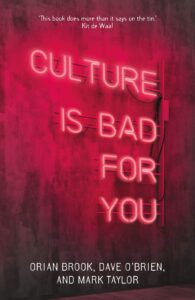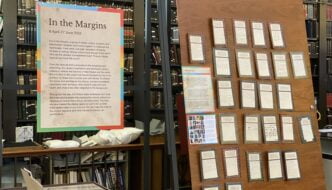‘Culture is Bad For You’: extract from the new study on inequality in the arts
September 24, 2020

Credit: Manchester University Press, https://manchesteruniversitypress.co.uk/9781526144164/
In their new book ‘Culture Is Bad For You’, Orian Brook, Dave O’Brien, and Mark Taylor look at the inequalities that exist in today’s creative industries. They explore how jobs in the arts and how the consumption of culture are affected by economic, racial and gender inequalities, shaping the cultural world we all live in.
In this extract, they share their interview with ‘Henna’, an aspiring creative, and introduce some of the book’s findings:
To start to understand the relationship between inequality and culture we can hear from Henna. Henna was one of 237 creative and cultural workers we interviewed for the research and analysis presented in this book. Like the rest of our participants we’ve given her a pseudonym, so she could be honest and open in the interview. We were asking her about her career, and working life.
Henna was in her early 30s at the time of the interview. She is a South Asian woman from a middle-class background, living in London and working in film and TV. As well as her middle-class origin, she had a degree from a very prestigious university.
To the outsider’s eye she had every possible advantage to ‘make it’ in her chosen cultural career. Yet she was blunt about the reality of working life:
“The UK film industry is not a meritocracy at all. It doesn’t matter if you’re intelligent or well-qualified or any of those things. What matters is who you know and who you’ve worked with. It’s also massively to do with being a woman of colour… They would much rather hire the white dude, and they feel more comfortable with the white dude, than the bolshy brown woman who seems to have done things that they don’t feel comfortable with. Of course. That’s just the reality of it.”
Henna tells us some of our reasons why we’ve written this book, and why we’ve given it the provocative title of Culture is bad for you. She gives us the starting point for why we should question some of the ‘good news’ about culture.
Henna was a successful film maker, with an international reputation. She was candid and blunt about her experiences in her cultural occupation. She reflected on the reasons that, despite her obvious talent and track record, she had not hit the same heights as some of her contemporaries.
‘Who you know and who you’ve worked with’ are how the labour market in film functions. The industry is risk averse as a result of the huge costs of production (and of subsequent distribution and marketing), set against the uncertainty of success.
The issue of risk in the film industry is reflected in other cultural occupations. We may know a great deal about audience tastes, but we can never really be sure of what will be a hit. It is hard to be sure if investment in developing a new artist, a new musician, a new play, or a new novel, will pay off.
Time, in film as in many other industries, is money.
This wasn’t all that Henna told us. She told us her gender, and the colour of her skin, were given less value than those of her white, male colleagues. This was despite the claims by parts of the film industry, and by government policy, that film is open to any and all who are talented.
This book tells the story of how Henna’s observation that film, and much of the rest of culture, is not a meritocracy. It is not enough to be talented and hard-working to make it.
We will see how the workforce in cultural occupations is deeply unequal, with class, race, and gender constituting crucial axes of inequality. Film and TV occupations are hostile to women; museums, galleries, and libraries are marked by their whiteness. Publishing is ‘posh’. The ‘poshness’ of specific cultural occupations, the absence of those from working class origins, is not a new thing. It is a longstanding problem.
Inequalities in who works in cultural occupations are driven by several factors. Low and no pay are crucial in excluding those without financial resources from entering cultural jobs. At key points in careers, women face hidden, and not so hidden, discrimination. Childhood engagement in culture is important in getting a cultural career later in life. There are significant inequalities as people grow up. In many occupations the default image of a cultural worker, as Henna points out, is a white man from a middle class background. People who are not part of that demographic group face substantial barriers to their success.
These are some examples of the dynamics that shape the sorts of culture we get. They shape the audience too. We will demonstrate how cultural consumption is highly unequal.
We sometimes think of culture as open to all. Government policy has made some museums free, and subsidised the cost of other artforms. Our analysis shows that engagement in many forms of government supported culture are, at best, a minority concern. This is true whether we look at ticket sales or we survey people about what they attend.
Cultural production and cultural consumption are the two areas of focus for our story about culture and inequality. These two areas have seen a longstanding and rich set of research traditions and agendas associated with them. We’re contributing new data and new analysis to this already extensive academic work…
This extract was taken from the introduction of ‘Culture is Bad For You: Inequality in the cultural and creative industries’ , published by Manchester University Press – you can purchase it here.
Filed under: Written & Spoken Word
Tagged with: arts and culture, books, British culture, creative class, creative industries, culture is bad for you, inequality, sociology, study



Comments